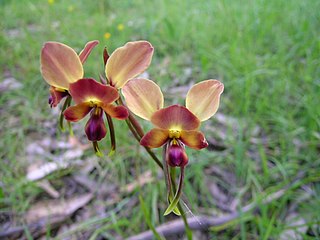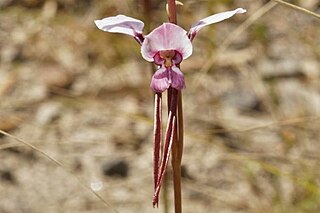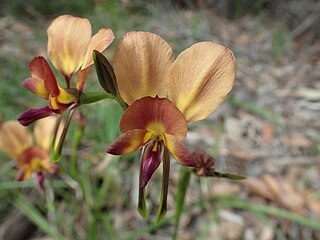
Diuris brumalis, commonly known as the winter donkey orchid, is a species of orchid that is endemic to the south-west of Western Australia. It is one of the first species of donkey orchid to flower in Western Australia each year and its flowers have been shown to attract the same insects that pollinate other species, but without offering a food reward.

Diuris corymbosa, commonly called the common donkey orchid or wallflower orchid, is a species of orchid which is endemic to the south-west of Western Australia. It is similar to the purple pansy orchid but its flowers are yellow rather than purple or mauve and it flowers earlier in the year. It also resembles the winter donkey orchid but flowers later than that species. It is one of the most common orchid species in the Perth area, often forms extensive colonies and usually has numerous flowers on the one spike.

Diuris drummondii, commonly known as the tall donkey orchid is a species of orchid which is endemic to the south-west of Western Australia. It is the tallest Diuris and is distinguished from the similar Diuris emarginata by its larger, more widely spaced flowers. The flowers are pale yellow with brown markings.

Diuris orientis, commonly called the wallflower orchid or eastern wallflower orchid, is a species of orchid which is endemic to eastern Australia. Like others in the genus Diuris, it has two ear-like petals and is similar to the common donkey orchid of Western Australia with which it has been confused. This species is found in New South Wales, Victoria, South Australia and Tasmania and its stalk-like petal "claw" is shorter in than those of D. corymbosa.

Diuris decrementa, commonly called the common bee orchid, is a species of orchid which is endemic to the south-west of Western Australia. It is similar to the bee orchid but its flowers are smaller and on a shorter flowering stem.

Diuris conspicillata, commonly called the spectacled donkey orchid is a species of orchid which is endemic to the south-west of Western Australia. It is an uncommon species, only found on two coastal granite outcrops, growing in shallow soil pockets.

Diuris magnifica, commonly called the large pansy orchid is a species of orchid which is endemic to the south-west of Western Australia. It has large, colourful flowers and is common in a narrow range near the coast around Perth, often occurring with the similar but smaller Diuris corymbosa.

Diuris punctata, commonly known as the purple donkey orchid is a species of orchid which is endemic to south-eastern continental Australia. It has two grass-like leaves and up to ten purple or mauve flowers, often with darker, sometimes yellow marks. A yellow form from near Guyra is probably now extinct.
Diuris amplissima, commonly called the giant donkey orchid is a species of orchid that is endemic to the south-west of Western Australia. It is a rare species and the largest Diuris in Western Australia. It has two or three leaves at its base and up to seven purple and dull yellowish-brown flowers on a tall flowering stem.

Diuris arenaria, commonly known as the Tomaree donkey orchid or sand doubletail is a species of orchid which is endemic to a very small area of New South Wales. It has two grass-like leaves and up to nine mauve or light purple and white flowers. It has a very limited distribution near Newcastle.

Diuris concinna, commonly called the elegant donkey orchid, is a species of orchid which is endemic to the south-west of Western Australia. It has up to five linear leaves at its base and up to five pale yellow flowers with brown markings. It is found along the south coast, often growing in areas that are flooded in winter and flowering more prolifically after fire the previous summer.
Diuris heberlei, commonly called Heberle's donkey orchid, is a species of orchid which is endemic to the south-west of Western Australia. It has three to five linear leaves at its base and up to four bright yellow flowers with a reddish brown border around the labellum callus. It is found along the south coast and is one of the last Diuris to flower in Western Australia.
Diuris immaculata, commonly known as the little Esperance bee orchid, is a rare species of orchid that is endemic to the south-west of Western Australia. It has between four and six leaves and up to three golden yellow flowers without markings. It is only known from near Esperance.

Diuris laevis, commonly known as the nanny goat orchid, is a rare species of orchid that is endemic to the south-west of Western Australia. It has between four and eight leaves and up to six pale yellow flowers which usually have reddish-brown markings. It has an unusually short dorsal sepal and wide labellum and is relatively common between Bunbury and Albany.
Diuris oporina, commonly called the autumn donkey orchid or northern white donkeys tails is a species of orchid that is endemic to Queensland. It has a single tapering, linear leaf at its base and up to ten white flowers with mauve to purple markings. It grows in the drier parts of the tablelands in Far North Queensland.
Diuris parvipetala, commonly known as slender purple donkey orchid, is a species of orchid that is endemic to eastern Australia. It usually has two leaves at its base and up to nine relatively small, whitish to mauve flowers with purple markings. It is an uncommon species found in northern New South Wales and southern Queensland.

Diuris picta, commonly called the granite bee orchid or granite donkey orchid, is a species of orchid which is endemic to the south-west of Western Australia. It has between three and five leaves at its base and up to eight creamy-white to yellow flowers with brownish purple markings. It grows on granite outcrops between Menzies and Lake King.
Diuris recurva, commonly called the mini donkey orchid is a species of orchid that is endemic to the south-west of Western Australia. It has one or two leaves at its base, up to six small pale yellow and brownish flowers and grows in winter-wet places between Badgingarra and Kalbarri.

Diuris setacea, commonly called the bristly donkey orchid, is a species of orchid that is endemic to the south-west of Western Australia. It has a tuft of up to ten twisted leaves at its base and up to seven yellow flowers with a few brown markings. It grows in moist soil on granite outcrops and flowers much more prolifically after fire the previous summer.

Diuris jonesii, commonly known as Dunsborough donkey orchid, is a species of orchid that is endemic to the south-west of Western Australia. It has large, yellow, brown and mauve flowers and is found in near-coastal areas between Dunsborough and Augusta.














